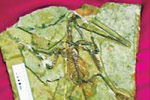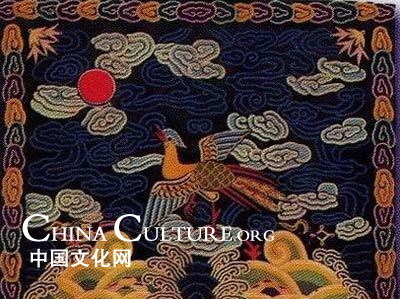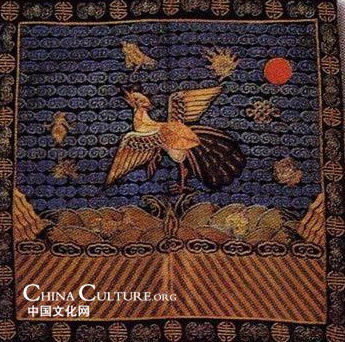Specials
The rank patches of the Ming and Qing dynasties
Updated: 2009-02-16 15:10
By Feng Hui (chinaculture.org)
|
|
|
|
The pattern for the third-rank officials was a peacock, because in ancient people’s opinion, the peacock was a virtuous bird representing auspiciousness and wealth.
|
|
|
|
The pattern for the fourth-rank officials was a wild goose. Since they would line up in flight, wild geese implied the order of feudal hierarchy, suggesting inferior officials had to respect and obey their superiors.
The pattern for fifth-rank officials was a silver pheasant, an auspicious and loyal bird since ancient times. As the legend went, Emperor Zhao Bing of the Song Dynasty once raised a silver pheasant. When the emperor committed suicide by casting himself into the sea, the loyal bird followed to death. Moved by this silver pheasant, people called it a royal bird and regarded it as a symbol of royalty and auspiciousness.
|
|
|
|
The pattern for sixth-rank officials was aigrette, a water fowl.
The pattern for seventh-rank officials was mandarin ducks always depicted in a pair. It is said that if they were separated, the ducks would pine for each other and die of loneliness. For this reason, mandarin ducks were used to show officials loyalty to the emperor.
|
|
|
|
The pattern for eighth-rank officials was a partridge. Because the Chinese pronunciation of partridge (An Chun) was similar to the Chinese phrase “Ping An”,meaning safety,officials used auspicious partridge as their rank patches.
The pattern for ninth-rank officials was a long-tailed flycatcher, symbolizing power and wealth.
Military officials’ rank patches
Military officers loved to use wild beasts as their rank patches, showing off their dignified manners
From first-rank to ninth-rank officers, the patterns for their rank patches were respectively unicorn, lion, leopard, tiger, bear, young tiger, rhinoceros and sea horse.
Specials

President Hu visits the US
President Hu Jintao is on a state visit to the US from Jan 18 to 21.

Ancient life
The discovery of the fossile of a female pterosaur nicknamed as Mrs T and her un-laid egg are shedding new light on ancient mysteries.

Economic Figures
China's GDP growth jumped 10.3 percent year-on-year in 2010, boosted by a faster-than-expected 9.8 percent expansion in the fourth quarter.



